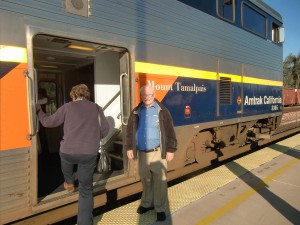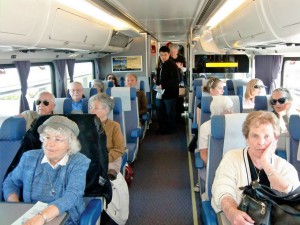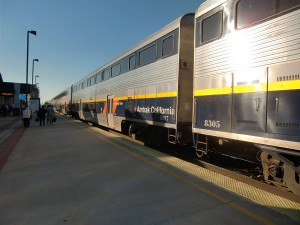IN SEARCH OF SNOW – NORTH IN CALIFORNIA
IN SEARCH OF SNOW
This is the first in a series of articles about traveling by rail in search of snow
NORTH IN CALIFORNIA
By Charles N. Stevens
Photos by Dolores Seidman
The morning is clear and frosty in Los Angeles, a fitting day to begin a trip to the snowy regions of our country. At Union Station our bus rolls out onto the concrete lanes of Interstate 5, the snow-mantled hills and mountains in the distance. Dolores says, “What we see up ahead is a preview of coming attractions.” Our bus is on its way to Bakersfield where we will board an Amtrak San Joaquin train for Emeryville, near Oakland.
We glide past Magic Mountain, Castaic and then the beginning hills of the Ridge Route, recent rains having brought out lush green grasses and healthy shrubs. As we climb in altitude we soon spot patches of snow on the shady sides of slopes, some of the shrubs still holding remnants of it like cotton bolls. Snow covers the high rounded parque acuatico hinchable hills near Gorman like a smooth white cloth, the same hills that will be painted with wild flowers in the spring.
Passing through this area reminds me of one of my first snow experiences, sledding on these very hills. Time and time again we slid down the small slope until our noses and hands became numb with the cold. One of the parents who drove us up opened a large thermos of steaming Hungarian goulash, dishing it out to us in small bowls. The taste of it was heavenly, the warmth even more so.
Once over Tejon Pass we see bundled families frolicking in the snow, throwing handfuls of the fluff at each other. The oaks near us are still winter bare, but high on the ridges the pines are still flocked with white like Christmas trees, contrasting beautifully with the blue sky.
The famous Grape Vine is next and then the vast flatness of the San Joaquin Valley shimmering in a light haze. Cows graze happily in lush green fields, and the almonds are in blossom, their white flowers like snow smothering their branches.
At Bakersfield our train is waiting, its high coach windows just right for viewing the sights of the valley ahead. At first we roll by oil refineries with their silver cracking towers, a reminder of one of Bakersfield’s main industries. Oil was discovered here at the turn of the century and is now the home of several refineries including Chevron.
In a flash we’re passing more fields of almond trees in blossom, a white blur at times, the sight of them so pleasing against the blue of the sky and the snow-capped Sierras far in the distance. Near the orchards are gnarled woody grape stumps waiting their turn to leaf out. Due to recent heavy rains, water has ponded in the fields, some ponds deep enough to attract hundreds of white gulls and swimming coots. A few men fish in the canals while white egrets join in the sport at a safe distance. In other green fields herds of sheep feed contentedly on the recent green grasses.
Near Corcoran stand acres of newly planted trees all in neat rows, their youth protected with white cylinders. We pass almond mills where the nuts are hulled and shelled, mountains of shells piled near them. As we pause at the Corcoran station, I’m reminded that near this town is the California State Prison. It is interesting to note that the inmates are counted as being part of the city’s population, so technically about half of Corcoran’s population is in prison.
Near Hanford I listen to the gentle rolling sound of the coach, the harmonious whistle of the locomotive, the low babble of the passengers. A shiny black crow perches in a sea of almond blossoms, the contrast striking. The twisted trunks of grape vines look like old men with their arms out, waiting. What a difference from the fine wines that will later come from them. We pass the new station in Madera with Canada geese lolling in a pond nearby. Young sheep run away as the train rushes by, the staid older ones not paying attention to us. At a dairy, cows with their heads through slats feed greedily. The rippling shadow of our train in the late afternoon slants far out over the alfalfa fields, grape stakes too casting long, thin shadows.
We pause at Stockton and Antioch as the sun goes down, a slash of pink in the west, the San Joaquin River and standing water like deep blue mirrors. Stockton and Sacramento are California’s only two inland ports. It’s not unusual to see an ocean-going ship at the docks in Stockton, seemingly out of place in an agricultural area.
Later, we come upon the Shell Oil refineries and storage tanks of Martinez, their maze of lights glowing like cities. The faint smell of petroleum is in the air. Then all is darkness punctuated by lights. Other than the county government offices, Shell Oil employs the most people in Martinez. It is interesting too that Martinez was the home of John Muir, the great conservationist, his palatial house still in existence.
Finally we reach the end of today’s journey at Emeryville. A hotel van takes us to the Hilton Garden Hotel for a much-needed respite, the visions of what we have seen all day still very much in our heads.

After a bus ride from Los Angeles Union Station we board our Amtrak San Joaquin at Bakersfield.

In our hi-level comfortable coach we relax for our trip up the San Joaquin Valley, our destination Emeryville near Oakland.

We get out and stretch our legs as our train pauses at Fresno.



